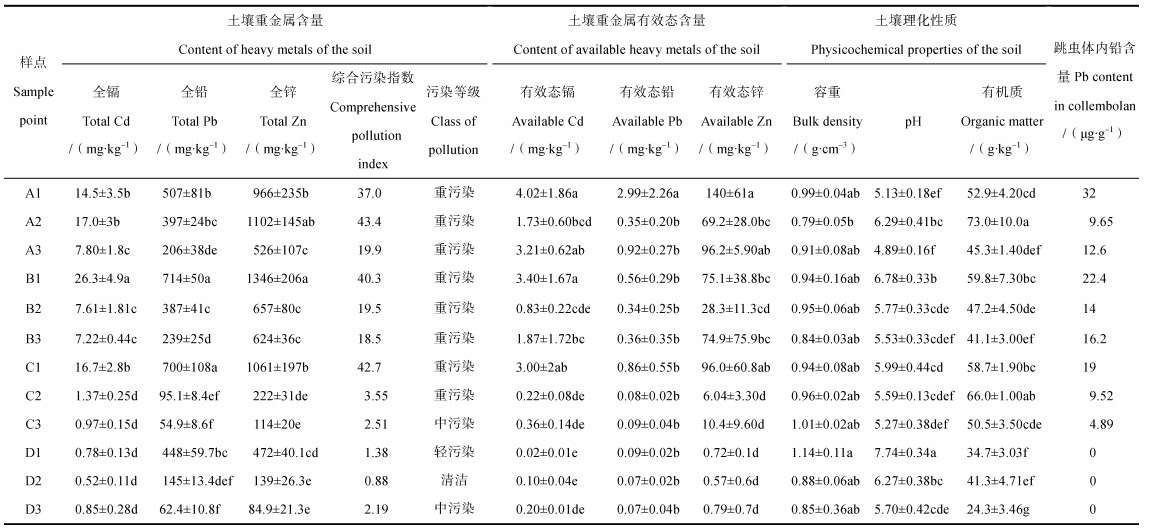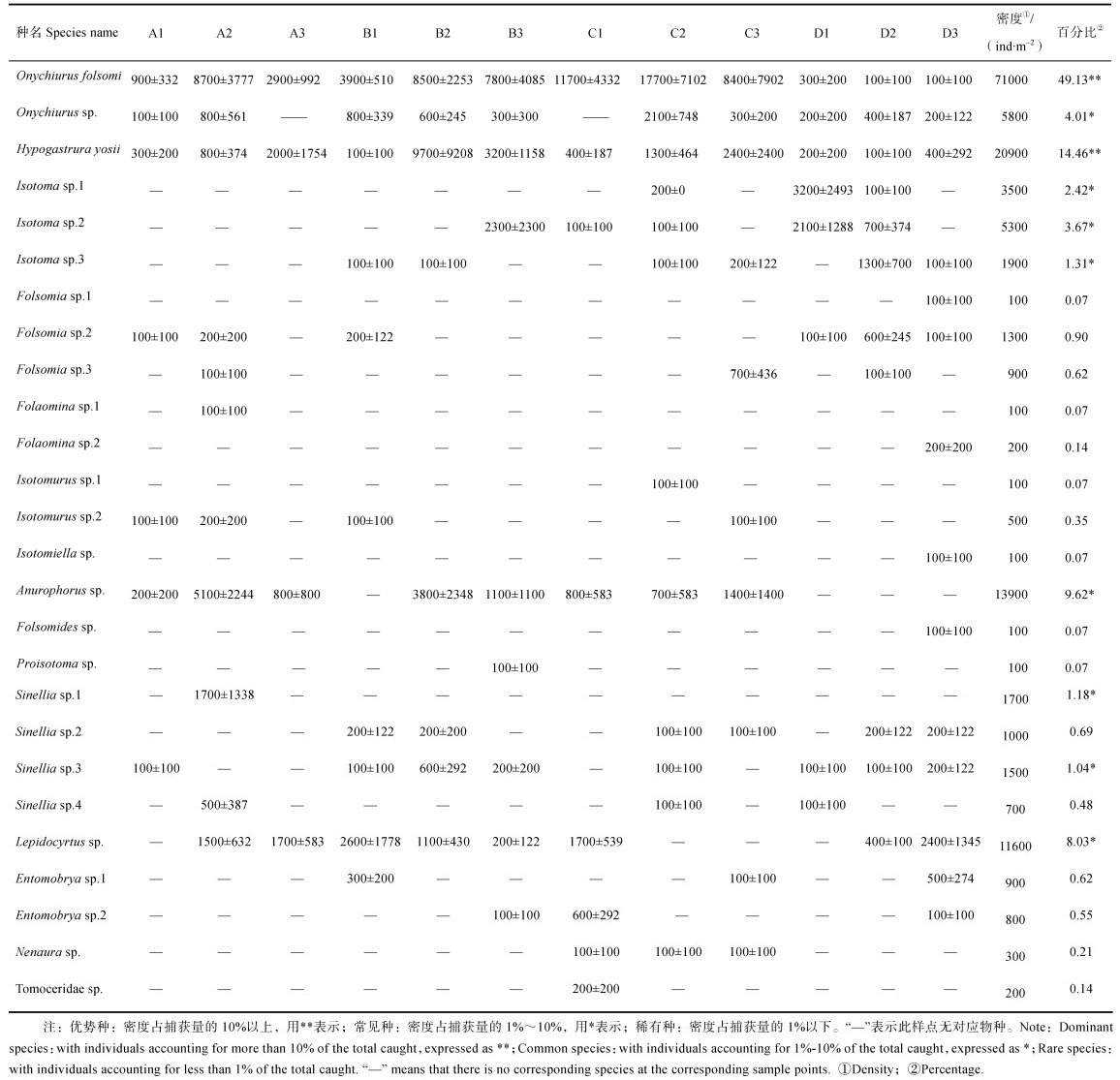2. 中国科学院分子植物科学卓越创新中心, 上海 200032;
3. 中国科学院南京土壤研究所, 南京 210008
2. CAS Center for Excellence in Molecular Plant Sciences, Shanghai 200032, China;
3. Institute of Soil Science, Chinese Academy of Sciences, Nanjing 210008, China
随着矿山开采、矿石冶炼和工业化的高速发展,土壤污染日益加剧,土壤重金属污染是当前人类所面临的重要环境问题之一[1]。土壤重金属污染导致土地质量退化,土壤生物多样性丧失,同时重金属可通过食物链传递威胁到人体健康。如何及时预警并修复污染土壤受到越来越多的关注[2]。目前,人们逐渐认识到土壤中重金属对土壤动物的影响(改变土壤动物的群落结构与种群特征)。研究重金属生物毒性可以较全面综合的评价重金属对土壤生态系统存在的潜在风险,从而为我国制定土壤污染管控相关的政策与法规提供理论依据。环境质量的生态风险评估等已成为最具实践意义的课题[3]。
指示生物物种的选择是生态风险评估的第一步,也是最重要的一步[4]。目前关于重金属对土壤动物影响研究颇多[1, 5],但在物种鉴定方面,大多鉴定到目或科,细分程度较低,难以筛选到能灵敏反映生态风险的物种,并在实际生态风险评估中应用;此外,土壤动物许多类群,种数与密度过少,参考价值不大;部分类群对重金属污染土壤环境的适应性和敏感性有限,在重金属含量稍偏高的土壤中很难寻获,无实际应用价值[6-7]。而跳虫作为土壤中的优势类群,不但种类繁多、数量巨大,而且分布广泛,在各类土壤环境中均有其活动的踪迹[8]。在土壤物质循环、能量转移、生态系统的维持方面起重要作用,具有土壤生物的典型代表性[9-10]。此外,跳虫生命活动范围一般在土壤的表层,是土壤环境变化的直接受害者,对环境的变化有很高的敏感性,同时部分类群又体现着很强的耐受性[11],其群落特征或某个物种不仅可以作为生态指标来评价土壤质量[12-13],又可指示土壤环境的污染状况[14]。Lock等[15]发现跳虫的密度和多样性均和锌的氯化钙提取态显著负相关,Gillet和Ponge[11]的研究表明土壤重金属污染将减少跳虫群落的生物多样性,但耐性种Mesaphorura macrochaeta的密度将会显著增加。研究跳虫群落结构和种群特征的变化能有效地反映土壤污染状况[4]。
本文以云南兰坪铅锌矿区周边的农田土壤为对象,研究土壤重金属污染和跳虫群落结构关系,探讨矿区重金属污染农田的跳虫群落结构和特定物种的变化特征,以了解污染对跳虫的毒害作用及跳虫对污染的响应规律,为土壤质量评价与监测提供科学依据。
1 材料与方法 1.1 研究区概况兰坪铅锌矿位于云南省兰坪县城西北18 km的凤凰山脉(99°32′E,26°41′N),平均海拔2 240 m以上,全年有霜期175 d,最高气温31.5℃,均温11.7℃,年均降雨量1015.5 mm,夏秋多雨,冬春干旱,为典型的亚热带、山地主体型季风气候。该矿床规模为特大型,是中国最大的铅锌矿[16-17],矿区集采、选、冶及辅助设施为一体,工业三废排放严重,周边农田土壤污染加剧,重金属富集[18]。
1.2 样点设置取样点设置在兰坪铅锌矿区周边的农田(图 1),在官庄、练登、新井、岩脚取4条取样带(分别距矿区中心约1 500、2 000、3 000、5 000 m),分别用A、B、C、D表示,其中A、B、C为污染区,D为非污染对照区。考虑到河流(流向从北至南)对农田的影响,距离河流每100 m取1个样点作1个梯度,共设3个梯度:梯度1(A1、B1、C1、D1)、梯度2(A2,B2、C2、D2)和梯度3(A3、B3、C3、D3)。每个样点5个重复,用定量取样器取两份20 cm2(面积)×10 cm(高)土壤样品,一份用作跳虫群落结构分析,一份用作重金属和土壤理化性质分析。
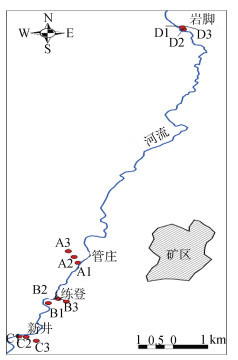
|
图 1 样点分布 Fig. 1 Distribution of sampling points |
用干漏斗法(Tullgren apparatus)分离提取跳虫[19],将跳虫制作成玻片标本,使用正置荧光显微镜(OLYMPUS,BX53),进行分类鉴定和数量统计[20-21],所有跳虫均鉴定到属或种。
1.4 土壤理化性质及重金属含量的测定土壤样品风干,用木槌碾碎,去除植物残体,分别过2 mm和0.2 mm筛,装袋备用。测定土壤的含水量、土壤容重(称重法)、pH(ThermoORION STAR A21型pH计法)、有机质含量(重铬酸钾氧化法),土壤的镉、铅、锌全量用火焰原子吸收分光光度计(Varian SpectrAA 220FS)测定,镉、铅、锌的有效态用0.01 mol·L-1氯化钙(CaCl2)溶液浸提,热电(Thermo)电感耦合等离子体质谱仪X2(ICP-MS)测定[22]。
1.5 跳虫体内铅含量的测定跳虫体内的铅含量采用微量生物样品中重金属测定方法[23]:准确称取50~150 μg样品至内径4.2 mm、长25.0 mm、厚1.3 mm的派热克斯玻璃管,加30 μL的消化剂(硝酸︰双氧水=3︰1)后,将小玻璃消化管放入5 mL烧杯内,烧杯放入聚四氟乙烯消化管内并在电热鼓风烘箱(DHG-9246)105℃加热消化4 h,冷却后置于玻璃培养皿内在电热板上烘干。小玻璃消化管4 ℃保存。测定时至少提前1 h加入50 μL 0.1 mol·L-1 HNO3溶解。使用原子吸收分光光度计(石墨炉,GFAAS)测定。
1.6 数据处理Shannon-Wiener多样性指数(H):H′=–∑ni/Nln(ni/N)
Pielou均匀度指数(JS):JS=H′/lnS
Simpson优势度指数(C):C=∑Pi2,Pi=ni/N
Margalef丰富度指数(D):D=(S-1)/lnN
Sorenson相似性指数(CS):CS=2j/(a+b)
式中,ni为第i个种的个体数,N为群落中所有种的个体数,S为种数,j为两个群落共有种数,a和b分别为样地A和样地B的种数。
应用内梅罗污染指数(P)对土壤重金属污染现状进行评价,评价标准采用我国土壤环境质量二级标准(GB15618-2018),计算单因子指数和综合指数[24]。
使用Excel 2016计算各样点环境因子(土壤理化性质、重金属全量、重金属有效态含量)的平均值、标准差,各种跳虫数量的平均值、标准误,进行土壤中铅含量与跳虫体内铅含量的回归分析。使用SPSS 21.0对各样点的环境因子进行单因素方差分析(One-way ANOVA)和双因素(样带、梯度)方差分析(Two-way ANOVA),对各样点跳虫的密度进行双因素(样带、梯度)方差分析。使用CANOCO for Windows v. 4.5生态学数据多元统计分析软件,对环境因子与跳虫群落进行去趋势对应分析(DCA)和线性模型-冗余分析(RDA),并做相应的非限制性蒙特卡罗置换检验(Unrestricted Monte Carlo Permutation Test)。
2 结果 2.1 土壤重金属和理化性质所调查的12个样点中,重金属污染情况和土壤理化性质差异显著(表 1、表 2)。样点距矿区或河流越远,综合污染指数下降。土壤镉、铅、锌的全量与其有效态分布趋势并不完全相同。除A2样点土壤容重偏小,其他各样点的土壤容重没有显著差异;除D1土壤呈微碱性外,其他样地土壤均呈弱酸性或中性。
|
|
表 1 土壤重金属含量、重金属有效态含量、土壤理化性质和跳虫体内铅含量 Table 1 Content of total heavy metals, content of available heavy metals, physiconchemical properties of the soil and Pb content in collembolan |
|
|
表 2 样点环境因子双因素(样带、梯度)方差分析(F值) Table 2 Two-way ANOVA(Transects, Gradients)of environmental factors at the sampling points(F value) |
跳虫体内铅含量与土壤铅含量的回归方程如图 2所示,结果显示跳虫体内铅含量与土壤中铅含量呈显著的线性关系(R2=0.41,P < 0.05)(图 2a);土壤有效态铅与与跳虫体内铅含量呈极显著对数关系(R2=0.82,P < 0.001)(图 2b),跳虫体内铅含量随土壤有效态铅或全量铅含量增加而增加。

|
图 2 跳虫体内铅含量与土壤铅全量(a)和有效态铅(b)含量的回归分析 Fig. 2 Regression analysis of Pb content in collembolan with total(a)and available(b)contents of Pb in soil |
从12个样点中,共获取土壤跳虫1 445只,隶属2目6科15属,共26个种(表 3)。从整体来看,平均密度为12 042 ind·m-2,其中优势类群为棘跳属Onychiurus和球角跳属Hypogastrura,分别占总密度的53.2%和14.5%。等节跳属Isotoma、符跳属Folsomia、缺弹等跳属Anurophorus、裸长跳属sinella、鳞长跳属Lepidocyrtus和长跳属Entomobrya均为常见类群,共占总类群的31.2%。其余1.18%为稀有类群,包括7个属。整体体现出优势类群明显,类群比较缺乏的特点。
|
|
表 3 兰坪矿区周边农田的跳虫群落组成 Table 3 Composition of collembola community in the surrounding farmland of Lanping mining area |
跳虫种数、丰富度指数均是对照D样带最高,分别为18和3.38;随着距矿区距离缩短而降低,C > B > A(表 4)。多样性指数和均匀性指数亦是D样带最高,分别为2.28和0.79。跳虫密度随距矿区变远而增多,C样带和B样带分别是A样带的1.80倍和1.67倍(F=3.212,P < 0.05),但D样带的密度则相对较低;优势度指数具有类似趋势(表 4)。D样带与A、B、C样带的相似度分别为0.53、0.69、0.74,即样带距矿区越远,与对照的相似度越高。从距河流远近梯度来看(表 5),跳虫种数、丰富度指数均是梯度3最高,分别为20和3.15。然后随着距河流距离缩短而降低,种数梯度2和梯度1分别为19和17,而丰富度指数梯度2和梯度1相同(表 5)。密度梯度2最高,分别是梯度1和梯度3的2.21倍和1.72倍(F=3.253,P < 0.05)。
|
|
表 4 4个样带的跳虫群落结构指数 Table 4 Structural index of the collembola communities relative to 4 transects |
|
|
表 5 3个梯度的跳虫群落结构指数 Table 5 Structural index of the2 collembola communities relative to 3 gradients |
通过对群落指数进行DCA分析,结果中四个轴的最大梯度为0.301 < 3。因此,采用RDA分析群落指数-环境因子相关性[25]。将所有测定的土壤环境因子(见表 1)与12个样点的群落指数(未列出)进行RDA分析(见图 3),提取的2个有效排序轴特征值分别为0.799和0.158,累计贡献率为95.7%,环境因子对群落指数的2个有效排序轴的解释量分别为82.5%和98.7%。
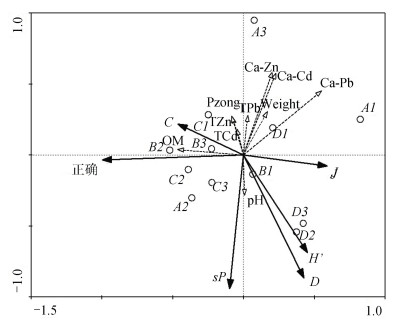
|
注:number,跳虫数量(密度),sp,种数,D,丰富度指数,H’,多样性指数,J,均匀度指数,C,优势度指数,Ca-Cd,有效态镉,Ca-Pb,有效态铅,Ca-Zn,有效态锌,Pzong,综合污染指数,TCd,全量镉,TPb,全量铅,TZn,全量锌,weight,土壤容重。Note:number:Individuals(density)of collembolans,sp:Number of species,D:Margalef index,H’:Shannon-Wiener index,J:Pielou index,C:Simpson index,Ca-Cd:Available Cd,Ca-Pb:Available Pb,Ca-Zn:Available Zn,Pzong:Comprehensive Pollution Index,TCd:Total Cd,TPb:Total Pb,TZn:Total Zn,Weight:Soil bulk density. 图 3 环境因子-群落结构指数RDA分析排序 Fig. 3 RDA ordination of environmental factor-community structure index |
对群落指数进行非限制性蒙特卡罗置换检验结果显示,种数受环境因子影响最大,与主要的影响因子有效态镉、铅、锌均呈负相关;其次为密度和丰富度指数。密度与有效态铅和有机质含量均关联密切,前者与其负相关,后者正相关。有效态锌、镉是降低丰富度指数的主因。多样性指数、均匀度指数与优势度指数受环境因子影响最小,与土壤理化性质相关较大,与重金属关联相对较小。
2.6 环境因子与跳虫物种的关联性通过对10个物种(优势种+常见种)进行DCA分析,结果中四个轴的最大梯度为2.467 < 3,因此,物种组成-环境因子相关应采用RDA分析。将土壤环境因子(表 1)与物种组成数据(表 3)进行RDA分析(图 4),提取的2个有效排序轴特征值分别为0.515和0.175,累计贡献率为69.0%,环境因子对群落指数的2个有效排序轴的解释量分别为53.1%和71.1%。对这10个物种进行非限制性蒙特卡罗置换检验。结果显示:棘跳属的Onychiurus sp与有效态镉、铅、锌较相关。Onychiurus sp.与土壤有机质呈正相关。同属于棘跳属的白棘跳(O. folsomi)作为绝对优势物种,有机质是最大的主导因子。等节跳属的三个种Isotoma sp.1、Isotoma sp.2和Isotoma sp.3均与全量及有效态镉关联较密切,均呈负相关(图 4);Isotoma sp.3与全量及有效态锌关联较密切。Isotoma sp.1与土壤pH和土壤容重关联度很高,均呈正相关,而Isotoma sp.3对重金属的关联适合度远高于土壤理化性质。Lepidocyrtus sp.与全量镉、铅、锌关联性较大且均呈正相关,尤其是镉。Anurophorus sp.和裸长角跳属的2个种Sinellia sp.1、Sinellia sp.3主要受土壤理化性质影响,尤其是有机质含量和土壤容重,Sinellia sp.1与全量镉、锌及综合污染指数也有一定关联。
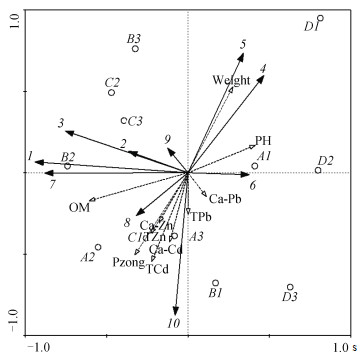
|
1,白棘跳Onychiurus folsomi,2,棘跳属Onychiurus sp.,3,吉井氏球角跳Hypogastrura yosii,4,等节跳属Isotoma sp.1,5,等节跳属Isotoma sp.2,6,等节跳属Isotoma sp.3,7,Anurophorus sp.,8,裸长脚跳Sinellia sp.1,9,裸长脚跳Sinellia sp.3,10,鳞跳属Lepidocyrtus sp. 图 4 环境因子-优势种+常见种RDA分析排序 Fig. 4 RDA ordination of environmental factor-dominant +common species |
D样带作为非污染区,其重金属含量总体远低于其他三个污染区样带;而A、B、C三个样带中,除A3外,其他样点均为随着距矿区和河流越来越远,综合污染指数均呈下降趋势。表明农田的重金属污染程度受着矿区与水流的双重影响,矿冶产生的重金属可随着风力和水流扩散,并且土壤对水流中重金属的滞留作用明显[26]。全镉、全锌、全铅之间均呈显著的正相关,说明属于同一污染源,镉可能是铅锌冶炼的衍生产物[16]。镉、铅、锌的有效态的分布趋势与全量分布并不相同。与全量相反,梯度2的有效态含量较梯度3要低,这与梯度2的较高pH和有机质含量有关,高pH和高有机质含量可以降低重金属的氯化钙提取态含量[27-28]。因此在双因素方差分析(样带、梯度)中,有效态含量在土壤理化性质的干扰下,不如全量的显著性高。
3.2 跳虫群落特征本次采样在9月份,共鉴定出跳虫6科15属26个种。平均密度为12 042 ind·m-2,在同季节的采样比较中,从数量上显著低于黄淮海平原的30 000 ind·m-2[29],可能与地域差异有关,也可能与兰坪矿区高度重金属污染有关;作为田间群落,类群数与黄淮海地区相差不大,都显著低于森林植被系统[30]。棘跳属占统治地位,与三江平原、黄淮海平原、黄河三角洲的调查结果一致[29-31]。总体优势物种明显,总物种丰富度相对匮乏,与国内外重金属污染地区的土壤动物调查结果一致[5-15],这是因为重金属污染致使一些生态幅较窄物种减少或消失,而少数优势种由于对重金属的耐受性强而表现出较高的丰度[32]。相比于三江平原、黄淮海平原、黄河三角洲等地,吉井氏球角跳Hypogastrura yosii密度上占比(14.43%),为该地的优势种,这是本地调查的一个重要特点。
3.3 跳虫群落结构及物种与重金属污染的关联根据调查的结果与分析发现,矿区周边农田系统中的跳虫群落结构和部分物种的分布造成显著的影响。距离矿区与河流的距离越近种数和丰富度指数越低,这与综合污染指数趋势相同;并且跳虫体内铅含量与土壤中的铅含量具显著的正相关。土壤动物体内的重金属含量通常代表着重金属对机体的直接入侵与毒害[33],在以往土壤动物的调查中,土壤动物体内的重金属含量与土壤中重金属含量呈明显正相关,而与种数、密度等呈明显的负相关[7, 34]。
在群落指数与环境因子的冗余分析中,种数、密度和丰富度指数受环境因子影响最大。其中有效态镉、铅、锌是导致种数减少的主因。有效态锌、镉是导致丰富度指数减少的主因,有效态铅是导致密度减少的主因,相比之下,重金属全量和综合污染指数与这些群落指数关联性不大,因为在实际田间土壤中,重金属的生物有效性很低,土壤全量金属不能反应真实的风险[35],而重金属有效态含量更能反映跳虫群落的变化。Lock等[15]在调查锌全量和其有效态对某煤矿的跳虫群落影响时发现有效态锌与跳虫的种数、密度、多样性指数相关性更大,其结果与本研究大致相同;而且本研究中铅有效态含量与跳虫体内铅含量具有更大的相关性亦说明重金属有效态含量相比于全量更能表明生态风险。本研究发现,种数较密度、丰富度指数敏感。其可能的原因为:首先,受到重金属污染,敏感物种在削减与灭亡的同时,适应污染的物种会占据并大量繁殖补充有利生态位,所以整体表现的变化为种数受到显著影响,而密度与丰富度指数稍受影响[36],这与以往的土壤动物研究一致[6];其次,有机质也是影响密度的主因,作为跳虫直接或间接利用的资源,有机质含量越高,对跳虫尤其是优势种的生存和发展更有利[31]。多样性指数、均匀度指数与优势度指数敏感性较差,一方面原因是农田生态系统中跳虫生物多样性较低,导致敏感程度本身不如种数、密度等指标,符合以往农田土壤动物群落的研究[1, 5],另一方面可能是因为跳虫较其他土壤动物更能适应重金属污染,耐性种更多,使得跳虫群落相比于整个土壤动物群落结构变化的不会那么明显。
部分物种在不同污染的重金属农田中密度存在很大的差异,一方面是部分种主要受重金属污染的干扰,这些物种有作为重金属污染指示种的潜力;一方面是部分物种主要受土壤理化性质的影响,这些物种有作为土壤质量指示种的潜力。在物种组成(优势种+常见种)与环境因子的冗余分析中,可以看出Onychiurus sp与重金属有效态关联密切,其密度在有效态低的样点较高,能反映污染区域的重金属生物有效性;等节跳属Isotoma的3个种均与镉有一定的负相关性,尤其Isotoma sp.3与综合污染指数、全量及有效态镉、铅、锌均有一定的关联性且对重金属的关联适合度远高于土壤理化性质,在综合污染指数较高的样地中显著少于综合污染指数较低的样地,适合做低污染区域的指示种,此结果与Lock等[15]的Isotoma viridis规律相似;Lepidocyrtus sp.同样与综合污染指数、全量镉、铅、锌关联密切且均为正相关,在综合污染指数较高的样地中显著多于综合污染指数较低的样地,适合做高污染区域的指示种,此结果与Winkler[14]的Lepidocyrtus cyaneus相反而与Lepidocyrtus tomosvaryi相似,说明了跳虫群落中不同属之间甚至不同种间,其对污染的响应也有很大差别,细分跳虫物种并筛选特定的指示物种很有必要。此外,优势种白棘跳Onychiurus folsomi喜好在有机质丰富、弱酸性土质中生存,与朱强根等[31]研究施用有机肥后棘跳属Onychiurus密度明显增长的结果相似。而且白棘跳耐受重金属,因此可以在偏酸有机质丰富的重金属农田中成为最优种,同为优势种的吉井氏球角跳Hypogastrura yosii也是喜酸的耐性种,两个优势种虽然不适合作为重金属的指示物种,但可考虑作为评价土壤质量的指示种。Isotoma sp.1与pH和土壤容重关系密切,也考虑作评价土壤质量的指示种。
4 结论铅锌矿区周边农田系统中的跳虫群落结构和部分物种的分布显著受到重金属污染影响:物种丰富度(种数)、个体数多度(密度)、丰富度指数等群落指数对重金属响应更大,且对重金属有效态的响应大于重金属全量,重金属有效态更能反映跳虫群落的变化;棘跳属的Onychiurus sp.、等节䖴属Isotoma的三个种、Lepidocyrtus sp.有作为相应重金属污染评价指示种的潜力。Onychiurus sp.和白棘跳Onychiurus folsomi、Isotoma sp.1有作为土壤质量指示种的潜力。
| [1] |
Li T, Li C Y, Yu D N, et al. Effects of heavy metals from road traffic on the community structure and spatial distribution of cropland soil animals (In Chinese)[J]. Acta Ecologica Sinica, 2010, 30(18): 5001-5011. [李涛, 李灿阳, 俞丹娜, 等. 交通要道重金属污染对农田土壤动物群落结构及空间分布的影响[J]. 生态学报, 2010, 30(18): 5001-5011.]
(  0) 0) |
| [2] |
Santamaria J M, Moraza M L, Elustondo D, et al. Diversity of Acari and Collembola along a pollution gradient in soils of a pre-Pyrenean forest ecosystem[J]. Environmental Engineering and Management Journal, 2012, 11(6): 1159-1169. DOI:10.30638/eemj.2012.140
(  0) 0) |
| [3] |
Liu Y R, He J Z, Zheng Y M. A review of application of springtails in ecological risk assessment of contaminated soils (In Chinese)[J]. Asian Journal of Ecotoxicology, 2008, 3(4): 323-330. [刘玉荣, 贺纪正, 郑袁明. 跳虫在土壤污染生态风险评价中的应用[J]. 生态毒理学报, 2008, 3(4): 323-330.]
(  0) 0) |
| [4] |
Xu J, Ke X, Song J, et al. Role of Collembola in assessment of ecological risk of heavy metal contamination of soils (In Chinese)[J]. Acta Pedologica Sinica, 2007, 44(3): 544-549. DOI:10.3321/j.issn:0564-3929.2007.03.023 [许杰, 柯欣, 宋静, 等. 弹尾目昆虫在土壤重金属污染生态风险评估中的应用[J]. 土壤学报, 2007, 44(3): 544-549.]
(  0) 0) |
| [5] |
Du X L, Ma J H, Lu C H, et al. Soil animals and their responses to soil heavy metal pollution in sewage irrigated farmland: A case study of the sewage irrigated area of Huafei River, Kaifeng City (In Chinese)[J]. Geographical Research, 2010, 29(4): 617-628. [杜习乐, 马建华, 吕昌河, 等. 污灌农田土壤动物及其对重金属污染的响应——以开封市化肥河污灌区为例[J]. 地理研究, 2010, 29(4): 617-628.]
(  0) 0) |
| [6] |
Migliorini M, Pigino G, Bianchi N, et al. The effects of heavy metal contamination on the soil arthropod community of a shooting range[J]. Environmental Pollution, 2004, 129(2): 331-340. DOI:10.1016/j.envpol.2003.09.025
(  0) 0) |
| [7] |
Ke X, Luo Y M. Role and existing indicators of soil animals in assessment of soil pollution and indication characteristics from their tolerence developed under stress (In Chinese)[J]. Asian Journal of Ecotoxicology, 2009, 4(4): 457-466. [柯欣, 骆永明. 土壤动物在污染评价中的作用、现行指标及胁迫环境下的耐受性[J]. 生态毒理学报, 2009, 4(4): 457-466.]
(  0) 0) |
| [8] |
Sterenborg I, Roelofs D. Field-selected cadmium tolerance in the springtail Orchesella cincta is correlated with increased metallothionein mRNA expression[J]. Insect Biochemistry and Molecular Biology, 2003, 33(7): 741-747. DOI:10.1016/S0965-1748(03)00070-5
(  0) 0) |
| [9] |
Coyle D R, Nagendra U J, Taylor M K, et al. Soil fauna responses to natural disturbances, invasive species, and global climate change: Current state of the science and a call to action[J]. Soil Biology & Biochemistry, 2017, 110: 116-133.
(  0) 0) |
| [10] |
Wolters V. Biodiversity of soil animals and its function[J]. European Journal of Soil Biology, 2001, 37(4): 221-227. DOI:10.1016/S1164-5563(01)01088-3
(  0) 0) |
| [11] |
Gillet S, Ponge J F. Changes in species assemblages and diets of Collembola along a gradient of metal pollution[J]. Applied Soil Ecology, 2003, 22(2): 127-138. DOI:10.1016/S0929-1393(02)00134-8
(  0) 0) |
| [12] |
Milano V, Maisto G, Baldantoni D, et al. The effect of urban park landscapes on soil Collembola diversity: A Mediterranean case study[J]. Landscape and Urban Planning, 2018, 180: 135-147. DOI:10.1016/j.landurbplan.2018.08.008
(  0) 0) |
| [13] |
Vincent Q, Leyval C, Beguiristain T, et al. Functional structure and composition of Collembola and soil macrofauna communities depend on abiotic parameters in derelict soils[J]. Applied Soil Ecology, 2018, 130: 259-270. DOI:10.1016/j.apsoil.2018.07.002
(  0) 0) |
| [14] |
Winkler D. Collembolan response to red mud pollution in Western Hungary[J]. Applied Soil Ecology, 2014, 83: 219-229. DOI:10.1016/j.apsoil.2013.07.006
(  0) 0) |
| [15] |
Lock K, Janssens F, Janssen C R. Effects of metal contamination on the activity and diversity of springtails in an ancient Pb-Zn mining area at Plombières, Belgium[J]. European Journal of Soil Biology, 2003, 39(1): 25-29. DOI:10.1016/S1164-5563(02)00006-7
(  0) 0) |
| [16] |
Deng W, Ji X L, Yuan W G, et al. Diversity of bacteria in Lanping Zinc-lead ore in Yunnan Province (In Chinese)[J]. Chinese Journal of Microecology, 2012, 24(2): 109-112. [邓伟, 季秀玲, 袁文功, 等. 云南兰坪铅锌矿区细菌多样性研究[J]. 中国微生态学杂志, 2012, 24(2): 109-112.]
(  0) 0) |
| [17] |
于法钦. 云南兰坪铅锌矿区植被及优势植物重金属含量研究[D]. 广州: 中山大学, 2005. Yu F Q. Vegetation and heavy metal concentrations of dominant plantsat lanping lead/zinc mine area in Yunnan Province[D]. Guangzhou: Sun Yat-sen University University, 2005. (  0) 0) |
| [18] |
Yang B X. Contents and pollution characteristics of Pb in the soil of maize field around lead-zinc mine area in Lanping County (In Chinese)[J]. Environmental Science Survey, 2013, 32(5): 6-9. DOI:10.3969/j.issn.1673-9655.2013.05.002 [杨炳旭. 兰坪铅锌矿区周边农田土壤-玉米体系Pb含量及其污染特征研究[J]. 环境科学导刊, 2013, 32(5): 6-9.]
(  0) 0) |
| [19] |
秦佳祎. 典型污染物对土壤弹尾目昆虫的生态毒性效应[D]. 南京: 南京师范大学, 2013. Qin J Y. Ecotoxicity of typical pollutants to soil Collembola insects[D]. Nanjing: Nanjing Normal University, 2013. (  0) 0) |
| [20] |
Yin W Y. Subtropical soil animals of China (In Chinese). Beijing: Science Press, 1992. [尹文英. 中国亚热带土壤动物[M]. 北京: 科学出版社, 1992.]
(  0) 0) |
| [21] |
Yin W Y. Pictorical keys to soil animals of China (In Chinese). Beijing: Science Press, 1998. [尹文英. 中国土壤动物检索图鉴[M]. 北京: 科学出版社, 1998.]
(  0) 0) |
| [22] |
朱冬. 土壤小型节肢动物食物链镉富集特征及其氮元素传递关联性研究[D]. 北京: 中国科学院大学, 2016. Zhu D. Enrichment of cadmium and its relationship to nitrogen transfer in a micro-arthropod food chain[D]. Beijing: University of Chinese Academy of Sciences, 2016. (  0) 0) |
| [23] |
Zhu D, Ke X, Wu L H, et al. Refinement of methodology for cadmium determination in soil micro-arthropod tissues[J]. Pedosphere, 2017, 27(3): 491-501. DOI:10.1016/S1002-0160(17)60345-X
(  0) 0) |
| [24] |
Sun L, Sun S Q, Yang C. Application of several comprehensive index methods in soil heavy metal pollution assessment: Take Huainan Mining Area as an example (In Chinese)[J]. Journal of Chifeng University: Natural Science Edition, 2013, 29(22): 34-36. DOI:10.3969/j.issn.1673-260X.2013.22.016 [孙雷, 孙世群, 杨晨. 几种综合指数方法在土壤重金属污染评价中的应用——以淮南矿区为例[J]. 赤峰学院学报: 自然科学版, 2013, 29(22): 34-36.]
(  0) 0) |
| [25] |
Lepš J, Šmilauer P. Multivariate analysis of ecological data using CANOCO . Cambridge: Cambridge University Press, 2003.
(  0) 0) |
| [26] |
Jiao Y M, Zhou H B, Shi Z T, et al. Relationship between the magnetic characteristics and heavy metal pollution of the river sediments in lead-zinc mining sites (In Chinese)[J]. Ecology and Environment, 2008, 17(1): 201-205. DOI:10.3969/j.issn.1674-5906.2008.01.039 [角媛梅, 周鸿斌, 史正涛, 等. 铅锌矿区河谷沉积物的磁学特征与重金属污染的关系[J]. 生态环境, 2008, 17(1): 201-205.]
(  0) 0) |
| [27] |
Bur T, Probst A, Bianco A, et al. Determining cadmium critical concentrations in natural soils by assessing Collembola mortality, reproduction and growth[J]. Ecotoxicology and Environmental Safety, 2010, 73(3): 415-422. DOI:10.1016/j.ecoenv.2009.10.010
(  0) 0) |
| [28] |
Dai W C, Ke X, Li Z, et al. Antioxidant enzyme activities of Folsomia candida and avoidance of soil metal contamination[J]. Environmental Science and Pollution Research, 2018, 25(3): 2889-2898. DOI:10.1007/s11356-017-0489-x
(  0) 0) |
| [29] |
Xie T Y, Xie G L, He F X, et al. Community structure of collembolans at shell island of Yellow River delta (In Chinese)[J]. Journal of Northeast Agricultural University, 2011, 42(9): 92-96. DOI:10.3969/j.issn.1005-9369.2011.09.019 [谢桐音, 谢桂林, 赫福霞, 等. 黄河三角洲贝壳堤岛跳虫群落研究[J]. 东北农业大学学报, 2011, 42(9): 92-96.]
(  0) 0) |
| [30] |
Jin Y L, You W H, Yi L, et al. Ecological distribution of Collembola in the litter of Tiantong forest ecosystems, Zhejiang (In Chinese)[J]. Ecology and Environmental Sciences, 2011, 20(2): 241-247. DOI:10.3969/j.issn.1674-5906.2011.02.006 [靳亚丽, 由文辉, 易兰, 等. 天童森林生态系统凋落物层跳虫群落的生态学研究[J]. 生态环境学报, 2011, 20(2): 241-247.]
(  0) 0) |
| [31] |
Zhu Q G, Zhu A N, Zhang J B, et al. Effect of long-term fertilization on soil collembola community in fluvo-aquic soil in North China (In Chinese)[J]. Acta Pedologica Sinica, 2010, 47(5): 946-952. [朱强根, 朱安宁, 张佳宝, 等. 华北潮土长期施肥对土壤跳虫群落的影响[J]. 土壤学报, 2010, 47(5): 946-952.]
(  0) 0) |
| [32] |
Wang Z Z, Zhang Y M, Yu Y F, et al. Effect of soil heavy meatal pollution on soil animal community in Hunan Songbaizhen zone (In Chinese)[J]. Journal of Natural Science of Hunan Normal University, 1989, 12(2): 166-171. [王振中, 张友梅, 喻运富, 等. 湖南省松柏地区重金属污染对农田土壤动物群落的影响[J]. 湖南师范大学自然科学学报, 1989, 12(2): 166-171.]
(  0) 0) |
| [33] |
Zhu D, Ke X, Wu L H, et al. Biological transfer of dietary cadmium in relation to nitrogen transfer and 15N fractionation in a soil collembolan-predatory mite food chain[J]. Soil Biology & Biochemistry, 2016, 101: 207-216.
(  0) 0) |
| [34] |
Niu X Q, Ren T, Tian X G, et al. The community organization and concentration of soil animals in heavy metal polluted areas: A case of the farmland around Linfen iron-works in Shanxi Province (In Chinese)[J]. Sichuan Journal of Zoology, 2013, 32(6): 889-897. [牛晓倩, 任婷, 田小刚, 等. 重金属污染区农田土壤动物群落结构及富集研究——以山西省临汾钢铁厂周围农田为例[J]. 四川动物, 2013, 32(6): 889-897.]
(  0) 0) |
| [35] |
van Gestel C A M. Scientific basis for extrapolating results from soil ecotoxicity tests to field conditions and the use of bioassays . Boston, MA: Springer US, 1997: 25-50.
(  0) 0) |
| [36] |
Bargagli R. Trace elements in terrestrial plants[M]//Trace elements in terrestrial plants: An ecophysiological approach to biomonitoring and biorecovery. Springer, 1998.
(  0) 0) |
 2021, Vol. 58
2021, Vol. 58



